The Jewelry City Steampunk Festival Puts Attleboro on the Creative Map (5 stars)
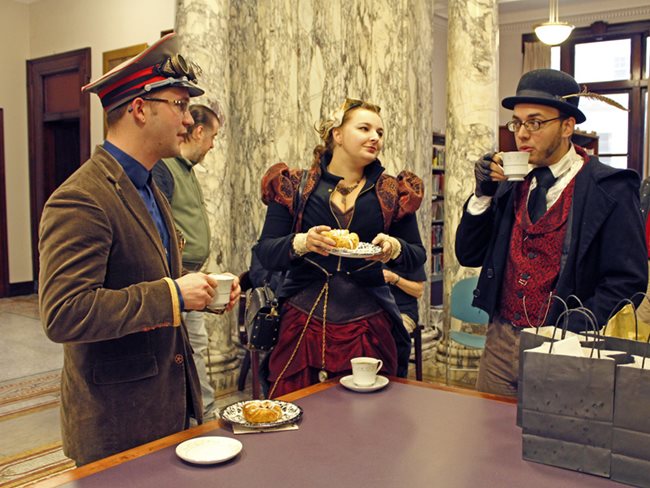
For the first time in my life, I’m a little proud to come from Attleboro. Like a lot of young people determined to set their own destiny, after high school I was eager to move away. This year, like a few thousand other attendees, I visited Attleboro for the Jewelry City Steampunk Festival, and was impressed by its highlighting of Attleboro as a creative center and historic site.
A steampunk festival is like a Renaissance festival, where visitors dress up as historical characters, with more thought to fun than accuracy. Whereas a Renn fest ignores the moral failings of medieval and Renaissance Europe to celebrate chivalry, knights, and monarchy, fans of steampunk celebrate the Industrial Revolution. (This got started in the early 19th century, but Steampunk generally is set in America or Britain in the later 1800s, the Victorian era, and sometimes the Edwardian Era, the pre-war 20th century). The ‘steam’ comes from the striking potential of the steam engine, and the ‘punk’ was supposed to make it sound hip and rebellious when the genre was invented in the 1980s (itself a period of enthusiastic futurism because of the personal computer).

Steampunk is a celebration of the future from the perspective of the past. In the past, that societies should make ‘progress’ was a new concept. It’s as if the science fiction themes of Jules Verne, author of 20,000 Leagues Under the Sea, all brass, gears, and steam engine pneumatics, grew as dominant technologies for decades, instead of being replaced by the gasoline engine, plastics, and, electronics.
New England’s largest steampunk festival is the Watch City Steampunk Festival in Waltham, which roots itself in local history, since Waltham was known as America’s watch capital. in the 19th century. Now the Jewelry City Steampunk Festival isn’t just located in Attleboro but boosts local pride by highlighting Attleboro’s history as America’s jewelry hub. It’s a festival of fun but with a purpose, to inspire the next generation of Attleboro’s leaders. It celebrates science and history. Festival co-organizer S. Matthew “Mort” Aod told me, “It gives people in Attleboro something to do with their kids. We support Attleboro-based events and festivities, and showcase the industrial history of the United States, focused on local history.”
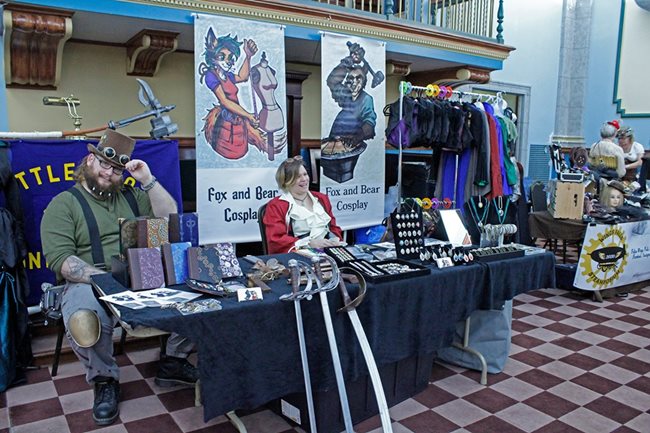
Now in its third year, the Jewelry City Steampunk Festival, which is free, attracted a few thousand attendees to Attleboro in October with a remarkably broad programs of events in nine locations. Working as an events journalist for 14 years, including being a resident contractor in the Boston Globe, I’ve been to numerous small town festivals, and this one is exceptionally well organized. They offer a full calendar of events with free program handouts. Maps are placed everywhere, clearly marking where the action is happening. It’s all within walking distance of the Attleboro commuter rail station, on the train line that runs between Providence and Boston.
Most importantly, the festival didn’t use filler to pretend to be larger than it really is. What I mean by this is, small town festivals generally have extra vendors selling crap like it’s a flea market, or somebody’s kid sister with no talent gets to give a panel or perform a song. The best sign of a festival’s potential is that every part of it is curated. There were no weak links in the parts of the Jewelry City Steampunk Festival that I saw. It made me think that this is a festival worth coming to from afar, one that will grow.

I was also impressed with the attendees. A third or sometimes even half of the visitors were dressed in costume! I met a lot of friendly people, who seemed eager to trade compliments on costumes or talk about history. So the festival wasn’t clique-y. I’ve been to a lot of street fairs where you don’t expect to interact with anyone except the vendors. At fan conventions like Arisia, people come to hang out with their friends, not meet strangers. But at the Jewelry City Steampunk Festival, people asked me (and I asked them) all day if I could take a photo, or to tell me about their costume. We traded tips on the festival schedule. I saw lots of excited, extremely cute kids and their parents (often equally excited).
Many of the costumes just had to make me laugh and think wow, who would have seen this in Attleboro. It made me feel like, maybe there are lots of creative people in Attleboro, but I just haven’t recognized them. Most wore a Victorian era long coat or dress. I saw characters with gears on their hat and brass goggles. One had a pith helmet from touring Africa. Another was a fur trapper with a Davey Crockett cap. There was even a full makeup ogre in uniform with brass gizmos who left me speechless. I just sort of gasped and said nothing. He said, “Yeah, it’s a lot to take in, isn’t it?” I had to laugh and agree.

Renaissance Fairs are a celebration of a fake history of Europe that is harmless, I suppose, but tends to bury historical truths about tyrannical monarchy, religious repression, treatment of women and minorities, class and poverty, and war. Historical accuracy isn’t that important to Steampunk, but many came eager to talk about some real history. The Jewelry City Steampunk Festival, which has educational aspirations, admirably partnered with Attleboro’s Women at Work Museum, which honors the Women’s Suffrage movement, through three event panels and a lackluster portable museum exhibit. That is a start. However, more is needed to temper the celebration of history with recognition of its failings. More outreach is needed to diverse local communities, who see less to celebrate in the past. Fortunately, New England’s 19th century was full of social critics including Thoreau, Emerson, Louisa May Alcott, Mark Twain, Harriet Beecher Stowe, Roger Williams, W.E.B. Du Bois, and Harriet Tubman, who would be welcome additions.
Another hallmark of a good festival is that events at the Jewelry City Steampunk Festival engaged its attendees. If you’ve been to the big, commercial fan conventions like Fan Expo, formerly Boston Comic Con, you’ll find that it’s mainly rows of vendors, and then panels where you sit passively while people on stage talk at you. At the Jewelry City Steampunk Festival, there are a couple of sit-down, shut up lectures, but its calendar is mainly audience-interactive. Kids can decorate pumpkins. There’s a photo booth hosted by Renée J. Fleury of Sky Captain Photography, so you can memorialize your costume. You can learn swordfighting, see a real steam engine, try improv comedy, and even become a comic book “adventurer” in a roleplaying scavenger hunt.

For example, I caught The King’s Busketeers, a band that played at the Park Street Ale House. Dressed in steampunk costume, they had great energy (they describe themselves as “high octane”!), singing and playing guitar, mandolin, banjo, fiddle, and a percussion box (pictured) that you sit on and whap with your palms. They got the crowd to clap along and even sing along. Thankfully, based in the ale house’s bar area, it wasn’t too loud for conversation in the adjacent dining area where costumed steampunkers ate lunch. (I’ve always felt that bands that set their speakers to 11 hoping that the volume energizes a crowd just don’t trust their actual music to move people.) Elsewhere, the festival features performers every hour or two, all day, including the Old Howard Troupe, and King Serpent Variety Troupe.
Because most of its events happens indoors, the Jewelry City Steampunk Festival calls itself New England’s largest indoor steampunk festival, and it seems to be true, but there is an outdoor component at The Balfour Riverwalk Park. It’s a small but attractive park that comes with a walkway alongside the Bungay River. The views of the river are lovely, especially with the leaves are turning fall colors. There you’ll find a few lawn games for kids, and the Athena School of Swordfighting gave attendees blunt wooden sticks and showed them how to make swordfighting moves.
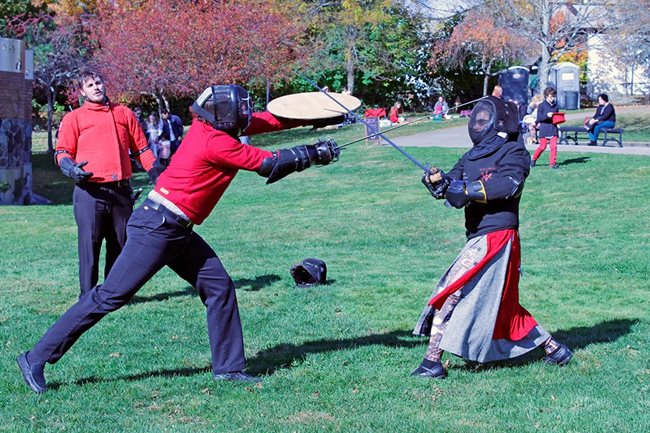
Across the street, I was surprised that the YMCA wasn’t part of the festivities. But the Centenary United Methodist Church hosts the Steampunk Bistro. It’s just a church basement, but they had a good variety of non-carnival food, at nearly free prices. You can get meatball and pulled pork sliders, hot dogs, salads, soups, a fudge brownie or pumpkin dessert, beverages, popcorn, and more. There was no proselytizing or religious feel to their part of the festival. Pro tip: the entrance is in the back. Outside was a single food truck.
Nearby, the Attleboro Public Library hosted Tiny Box Theatre in its marble lobby. Wow! It’s a stunning library foyer with columns and walls of marble. It and the library, built in 1907, are good settings for feeling steampunk.
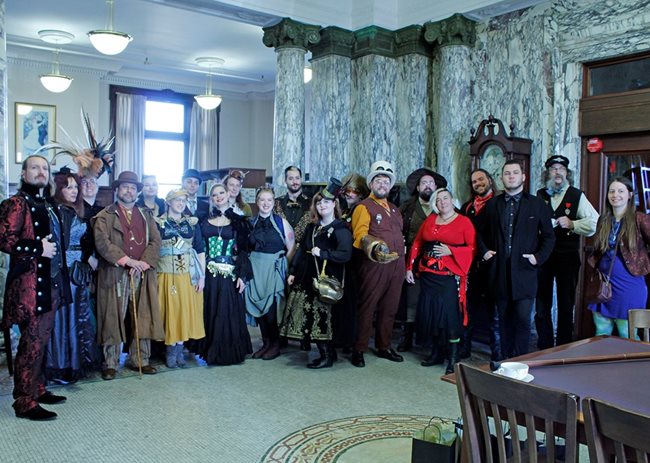
One of the troupe, Joy Tomasko, told me that Tiny Box Theatre is based out of New York City, and that they repurpose old boxes, incorporating them into shows meant for one or two people at a time, and just a few minutes long. You and the performer, wearing a steampunk costume, stand next to the box, for example a wooden drawer from a library card catalog, which is decorated with tiny items, sort of a custom doll house. Then you wear headphones, and so does the performer. Pro tip: just ask, and the performer can adjust the height of the box, or even offer you a chair. There’s plenty of seating to observe those ahead of you in line while you wait.
A recording tells you a story, and while the recording plays, the performer points or activates different items in the box. This was far more interesting than I was expecting, and because you’re close enough to touch the box, you become part of the show. You search for hidden tiny items, choose tiny items to progress the story, and make discoveries as new portions of the box are revealed. Pro tip: You’re more likely to find hidden items by careful searching than by frantic digging.
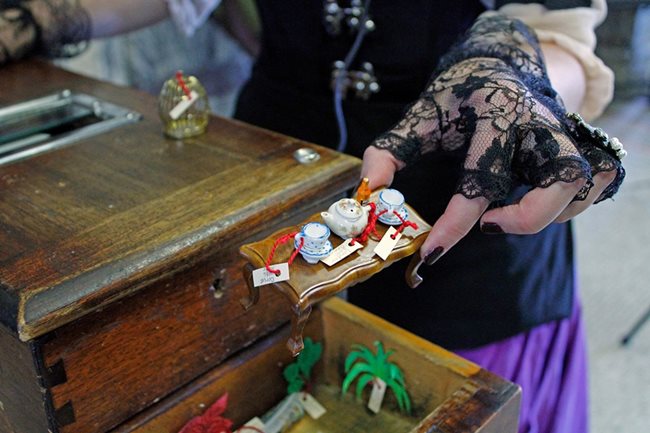
A second experience has no performer, and acts like a choose-your-own-adventure book. It’s a library card catalog box with library cards. You read the first cards and make a decision, which sends you either to one next card that continues the story, or to some other next card. Of course you can backtrack and try different pathways, if nobody’s waiting behind you for the experience.
Tiny Box Theatre is truly unique, and because it’s such an intimate experience, so close up and with tiny items, you bond with the performer and with the mysterious story that you is symbolized by up-close items in the box. Listening to a recording with headphones on isolates you slightly from your environment and from engaging the performer directly. This is partly intentional, as the performer, like a puppeteer, is not really part of the story but serves to activate the components in the box. And having headphones allows more than one Tiny Box Theatre performance to take place in the same space at the same time. However, it would be even more potent to engage with the performer live, having him or her tell us the story directly, and recorded sound effects could still be added on top of that, without headphones.
The tales were engaging, but the stories were slightly formulaic and mostly about the box instead of people (one character is just called “The Author”). And the self-guided experience didn’t introduce the world of the story enough for me to make choices in the world of the story. However, it was a fascinating take on theatre performance, and I appreciated their including life lessons.
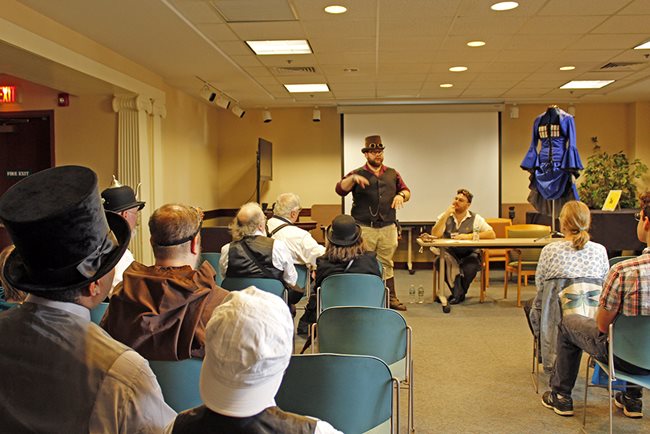
I also visited the library’s community room, which seats 45 people for panels and events. I just missed a discussion how to create fictional worlds and what steampunk means, hosted by Citizens of Antiford, a steampunk community. But speaker Sam Sarette kindly allowed a short interview.
Events INSIDER: What is worldbuilding?
Sam Sarette: It’s the art of creating a fictional steampunk world. We dove into some of the aspects of steampunk and borrowing from history that affects steampunk worlds differently. Some people do it for making art, and we use it to fuel writing stories in our story-writing community. There are a lot of general rules, and then dealing with certain societal aspects such as classicism, racism, and also political systems such as anarchism and communism, which were reactions to the industrial revolution. At the end of the 1800s, that’s when they were thinking about all those ideas, which came out of the industrial revolution.
Events INSIDER: Steampunk is set in the past, right?
Sam Sarette: Steampunk can be Victorian or Edwardian [from 1837 to World War I]. Learn it and add it to your own world as you see fit. With steampunk fiction, you can take history and create a fork, asking, “What would happen is this technology or culture were different?” That’s a very interesting way to go. Like, what if Charles Baggage’s machines [early computers made of gears before electronics] took off and created a computer revolution a century early? Or what if the Civil War had a technological arms race that kept it going for decades? There’s also a Tolkienesque way of creating a world from scratch, but beg, borrow, and steal from history.
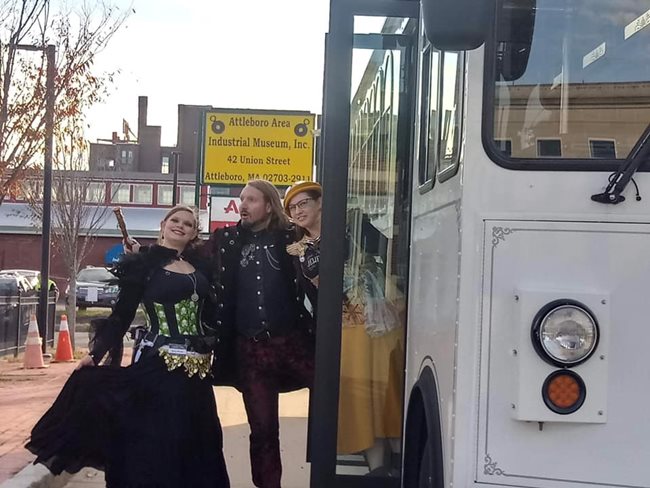
The festival’s venues are all within walking distance, but a free trolley was provided by Rockstar Limo, that takes you swiftly between the Attleboro Public Library and the Attleboro Area Industrial Museum. The trolley was fun, and old-timey looking enough on the inside with its natural wood seating. Pro tip: If you’re shy about meeting people, ride the trolley, where you’ll be sitting with talkative strangers. Or just compliment someone on what they are wearing, as a conversation starter.
The Attleboro Area Industrial Museum, which is free and open year-round, played host to the festival as well. It tells the story of Attleboro’s manufacturing history, especially its jewelry industry, a step more sophisticated than old-time blacksmith shops you might find, for example, at Old Sturbridge Village. Though small, it punches above its weight, with a surprising variety of engaging exhibits. Outside of automobile and airplane museums, New England has few industrial museums. (The Boott Cotton Mills Museum, Charles River Museum of Industry, and American Clock and Watch Museum come to mind.) During the festival, an inventor showed off a working steam engine, though running on compressed air instead of steam for safety.
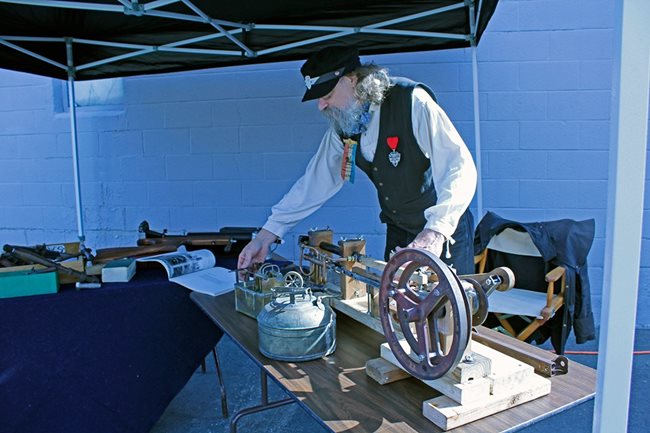
Inside, the Attleboro Area Industrial Museum has several mannequins showing how artists and machinists performed their craft. They show off not just jewelry but old time ice skates, sewing machines, and adding machines. You’ll see the machinery used to make jewelry, and mesh shirts and handbags from the 1920s. You’ll see a giant balance scale, a cylindrical toolbox made from an old stove pipe’s pieces and fitting. There’s a quilt highlighting African-American inventors. There’s a foot-pedal lathe and sewing machine. They have large, clean restrooms.
There’s a diorama of a jewelry craftsman’s shop from the 19th century, a function room for festival panels, and a crafts room where kids and adults you can make their own jewelry. There’s an exhibit dedicated to a sculptor who worked in bronze and designed the head of Hasbro’s GI Joe doll. (“Action figure”, please!) To make jewelry of course you’re often working with very small designs and metalwork, so you can try a ‘micrometer’ used for precision measurements. They have a ‘shadowgraph’, a device that magnifies the shadow of a small object so it can be measured. There’s an exhibit on the “radio proximity fuse“, which they claim was the 2nd most important device, after the nuclear bomb, to America winning World War II. Pro tip: ask staff to demonstrate some of the jewelry-making machines, which still work!
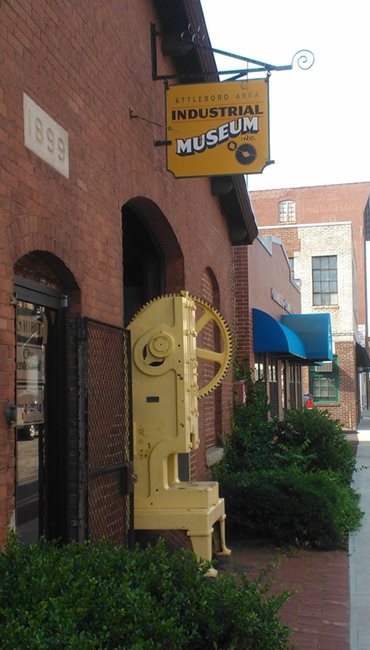
The Attleboro Area Industrial Museum is small, and the curation is simple, just paper print outs sometimes laminated. But there’s a lot of heart in the place, and no barriers between you and the old-time items and machines. I found it far more engaging than, for example, the rather empty American Independence Museum (4 stars). Properly funded, it would be on the same level as the amazing, working antique mechanisms of the American Clock and Watch Museum in Connecticut. Pro tip: try their entertaining exhibit called “The Craftsman”, a game of skill and chance where you start as an apprentice in some trade such as barrel making, and try to become a master craftsman.
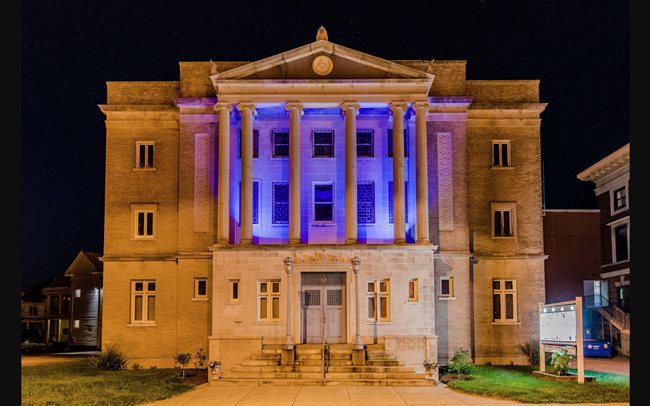
Another space for the Jewelry City Steampunk Festival is the Masonic lodge in Attleboro. Their one-room museum is more strange than inviting with its history of rituals and symbols. However, the masons aren’t the secret Illuminati, but just a community club that helps numerous charities. They run a Polar Plunge for the Special Olympics, have worked on houses for Habitat for Humanity, volunteer at a suicide prevention walk, and more. Their lodge building is more than a century old and thus served as a fantastic, old-timey setting for steampunk revelry, which took place on each of the five floors.

Outdoors and indoors, you’ll find 40 vendors, selling handmade crafts that are often steampunk-themed, including portraits, hats, costuming, jewelry, candles, scrubs, corsets, hats, but also non-steampunk arts such as quilts, masks, pottery, and Halloween decorations. One notable table was Owl’s Glen Studios, run by Seth Paquette. There you’ll find a variety of mysterious brass inventions, not meant to do anything except evoke curiosity as to what their purpose might be in a fantasy world. They are conversation starters that evoke untold heroic adventures.

I was also glad to take part in a “Live Adventure Game” (or LARP) run by Curious Experience Design. They recruited “adventurers” and gave them tasks such as a puzzle solving, a scavenger hunt, and encountering characters. Guides including founder Daud Alzayer stayed with us and encouraged us, giving hints where needed. This highly interactive experience gets you moving around the space, even up and down the stairs to different floors. The experience was perhaps too short and its fantasy world didn’t make a ton of sense, but they stuck with the two most important success factors with LARPing: keeping it simple enough for everyone to “get it”, and making it tons of fun. They regularly run themed “murder mystery” and other interactive events. Take note of their upcoming interactive Steampunk game party at Castle Hill, a real mansion on the North Shore on November 16. Each goes beyond just a theme party to giving guests a role in an immersive story.
The one-day Jewelry City Steampunk Festival closed with a costume competition and parade, and then later a party again at the Masonic lodge. They served food for a generously low donation, and some vendors stayed open late. The party featured bellydancing, a carnival performance, and live music by steampunk band Victor and the Bully.
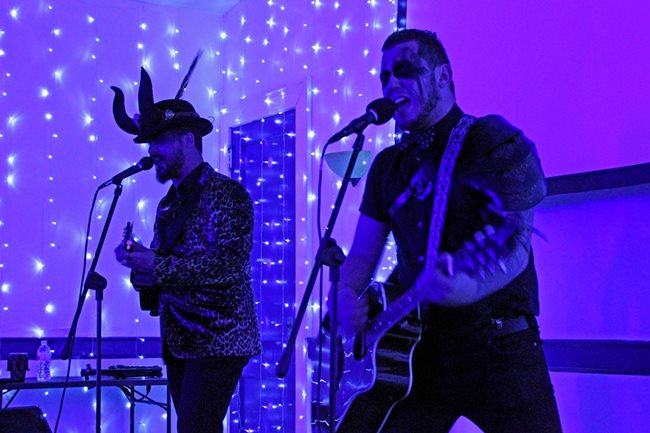
I sat and chatted with several partygoers, including Dave Lubelczyk, who lives in Attleboro. He told me, “It’s a really awesome event. It’s a growing event. It’s not as big as Watch City Steampunk Festival, but for a third year, I think they’ve done an excellent job at growing the event. For a growing event, they’ve got a great amount of vendors, great amount of activities, and are really integrated with the other steampunk communities around here.”
I grew up in the Attleboro area, and as part of writing this article, I returned to the Attleboro Area Industrial Museum for more information. Coming to the Attleboro downtown area near the commuter rail station, I felt a touch of shame to see ugly, abandoned store and factory buildings. A homeless woman pushed a stolen shopping cart up the middle of the road, and going the other way was a “man cave” guy in pajama bottoms holding two unlit cigarettes in his mouth.
But thanks to the Jewelry City Steampunk Festival, I think of Attleboro as its own place, a destination for tourists and residents, not just a satellite of Providence and Boston. It coincides with a City of Attleboro renovation project meant to revitalize its downtown. It reminds me of the change that Providence has seen. When my father was a teenager in the 1950s, so he tells me, downtown Providence was dangerous, a commercial district that was abandoned at night. Now arts, restaurants, museums, the Providence Place Mall, and the renovation of the Providence River walkways have boosted daytime and evening tourism in Providence.
I would love to see such a transformation in Attleboro. Attracting artists is part of that equation, and the Jewelry City Steampunk Festival and Attleboro Area Industrial Museum is part of that. It successfully recasts Attleboro as an artistic center, while recognizing local history.

After 14 years of writing about events, mainly festivals, I’ve seen it all and get bored easily. For example, I spent less than an hour at the recent Necronomicon festival, a horror-themed fan convention in Providence. That’s why I’m so excited to have discovered the Jewelry City Steampunk Festival, where I stayed all day. The Jewelry City Steampunk Festival is still a growing annual event, and their calendar clash with ubiquitous costume events (especially at night) of the Saturday before Halloween was a bad idea. But every part of the Jewelry City Steampunk Festival, which is sponsored by the Attleboro Cultural Council, shows creativity and professionalism. They’ve got the creativity and management skills, and community engagement, to showcase Attleboro as a regional attraction, not just a local attraction. That is a step up for my hometown area. I’m proud.
I’ll give the Jewelry City Steampunk Festival a full 5 stars. Note the upcoming interactive Steampunk game party at Castle Hill, and the Club Drosselmeyer 1942 event at Harvard’s Club OBERON this December.
For more see the Jewelry City Steampunk Festival online.
Photo credit: Lindsay Davignon, except the King’s Busketeers, museum exterior, and lodge exterior.